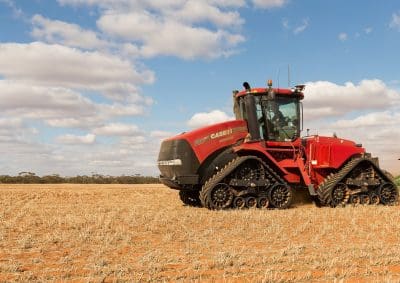TOO much wheel slip on sand hills, resulting in erosion and uneven crops, encouraged Victorian farmers, Tim and Richie Gleeson, to look at track technology.
The Gleesons grow wheat, barley, lentils, chickpeas, lupins and canola on 18,000 hectares at Natya, 60 kilometres north of Swan Hill, in Victoria’s Mallee.
In early 2015, they bought two Case IH Steiger 600 Quadtrac tractors.
E.T. Gleeson and Sons farm manager, Scott Gladman, said the district had big sand hills and growers were getting a lot of wheel slip climbing them with tyre tractors — even four-wheel-drive tractors.
“The wheel slip incorporates chemical into the ground where you don’t want it, which can then make your crop over the sand hills sick or die, exposing them to wind and resulting in erosion,” he said.
Mr Gladman said despite the Gleesons’ previous tractors having “plenty of horsepower”, they couldn’t climb some of the sand hills.
“So we’d have to drive up where the sand hill wasn’t as steep, and sow down it. That’s just not as productive; plus by doing that, we were running over what we’d already seeded, and crops in those areas often just didn’t come up. It was really impractical.”
He said neither could the tractors always pull a bar up the sand hills.
“The wheels would start spinning, then they’d dig a hole and the tractor would stop — bogged.”
After “putting up with it for long enough”, the Gleesons’ research led them to tracked tractors, which Case IH first introduced in 1996.
Having previously had Case IH tractors, Mr Gladman said the Gleesons knew and liked the brand, including the “fairly substantial warranty”.
The Quadtrac’s four individually driven, oscillating tracks give greater ground contact than tyres or two-track systems, resulting in a good balance between productivity and efficiency.
The cropping operation took delivery of the Case IH Steiger 600 Quadtrac tractors just before seeding last year. Since then, they’ve done well over 2000 hours of seeding and harvesting.
“They probably do around the same amount of driving around with the chaser bin on as what they did at cropping time, so it’s not as if they have just done a seeding of 500 hours and then been parked in the shed. We’ve worked them, and haven’t had an issue.”
Mr Gladman said while the initial capital outlay sometimes seemed more, the return on investment was excellent.
“In the long run, per hectare it works out cheaper because we’re getting over sand hills that we don’t have to turn around and sow downhill. Even fuel use with these equates to a lot less per hectare because it’s just up and over, and from one end of the paddock to the other, without messing around, having to stop and drive somewhere where you can get up the top of the hill and sow down in 10 or so goes,” he said.
Similarly, towing 20 tonnes in a box behind, or the bar, has also been no problem.
“The other tractors felt it when the box was full going over a hill, and we used to have more trouble actually getting over the hill in the first place. But these Quadtracs, we don’t know whether the box is full or half empty, it just feels the same all the time.
“Initially we didn’t think they had enough horsepower, but that was due to the fact that they get so much positive power to the ground, that you’re using all the horsepower.
“Whereas with a wheel tractor, when the wheels are spinning the revs still stay up high, and you don’t realise that you’re getting all that wheel slip. You get this false sense that the tractor’s pulling up the sand hill easily — but it’s not, it’s actually spinning the wheels, digging out the sand in front of you and not getting power to the ground. At 100 per cent wheel slip, you’re not going anywhere — you’re bogged!
“This has been a good transition: these Quadtracs do exactly what we bought them to do. We haven’t had to seed down a single sand hill since — at all. We just go straight up and over, no problem.”
Source: Case IH



HAVE YOUR SAY